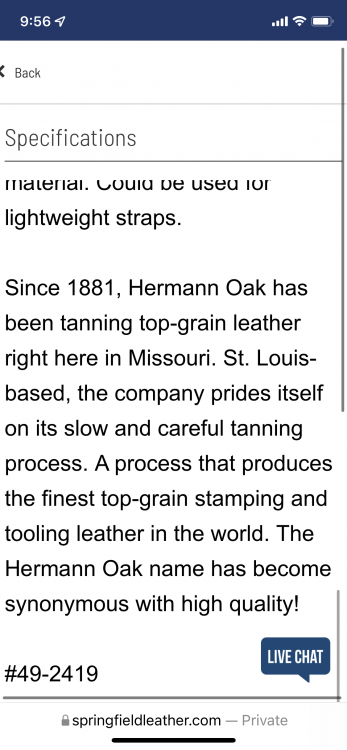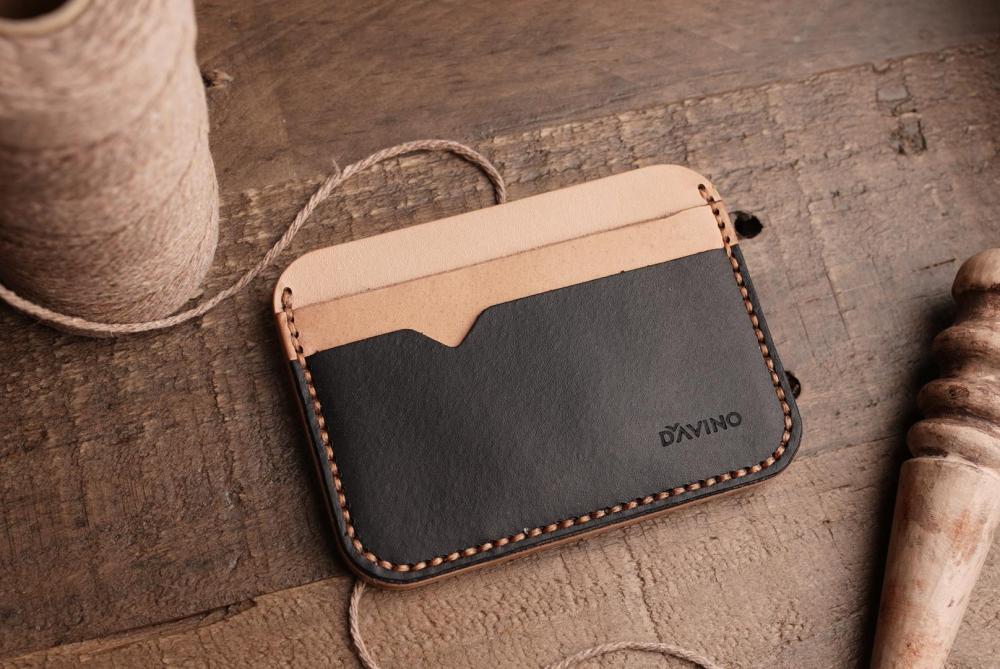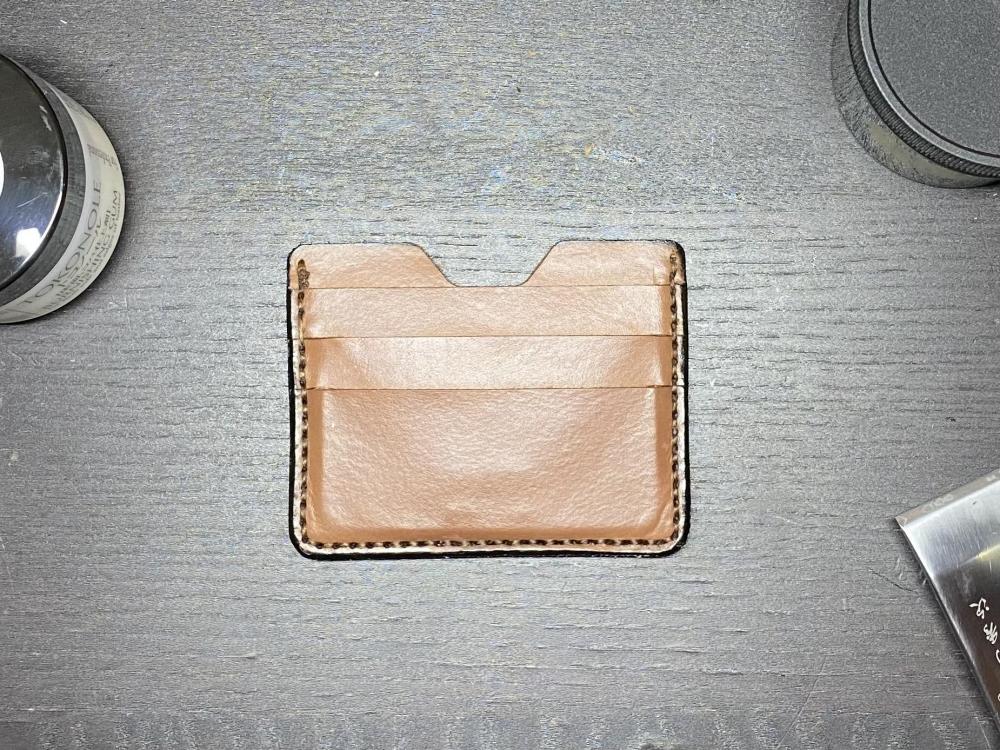
Piko
Members-
Posts
70 -
Joined
-
Last visited
Content Type
Profiles
Forums
Events
Blogs
Gallery
Everything posted by Piko
-
Thank you for the info!
-
How do you deal with consistency in leather?
Piko replied to Piko's topic in Leatherwork Conversation
Mike, I lasercut so no irons (although i have 4mm round and 3mm dimonds). I skive the T pocket. I dont understand skiving the edge. If I do, if I understand thus correctly, it would shave bulk from the edges once they are glues and stitched. But the rest of the wallet, will be thicker than the sides the are skived. I don't ee the point in that. I like how thick the wllet is ne when i burnish it it loos like wood. Pretty cool. thank you -
How do you deal with consistency in leather?
Piko replied to Piko's topic in Leatherwork Conversation
Thank you! i am making wallets. The main structure is 2mm thick (5-6 oz) and the outside pockets are 1mm (2-3oz) see the photo, that’s what I am making. i’ve only used Veg Tan from Amazon and Tandy so far so I am yet to experiment with different leathers like Pueblo. cant wait. -
How do you deal with consistency in leather?
Piko replied to Piko's topic in Leatherwork Conversation
Touche’ on the Alto, Hardrada. I laser-cut mostly to avoid punch in in the holes. I plan in moving soon and I’ll have a better place: for now this is all I can do. Ok, so pueblo is finished. I am still trying to make sense of conditioners, top layers etc but again, it has been two months. I am light years behind you guys. Love the items btw, good job! And thanks for the tips -
How do you deal with consistency in leather?
Piko replied to Piko's topic in Leatherwork Conversation
You put Tokonole on the whole grain side? Do you burnish it with glass or just let it dry? Then you apply Saphir wax? those are great tips, thank you! -
How do you deal with consistency in leather?
Piko replied to Piko's topic in Leatherwork Conversation
Hardrada, now thats a good looking wallet. i recently purchased some pueblo leather and a liner from RML but waiting for delivery. I laser cut the leather so I am not sure how a finished leather will behave under the laser. I guess I’ll find out soon enough. To tell you the truth, I don’t even know what ‘finished’ leather is. One thing I got to point out about English is that you guys use a lot of same words to descrive something completely different-ie top as in best and apical layer. Finished as a completed item as well as lacquered or painted etc. So I am still learning the terms. i am not sure if the Pueblo leather i bought is finished or not. Oh, and good point on the ‘free’. Did not think about it. I went with RML because they split leather. If it cuts under my laser and the fumes don’t kill me…I guess I’ll stick with them otherwise they’d have lost a potential customer (lol). thank you for your help. -
How do you deal with consistency in leather?
Piko replied to Piko's topic in Leatherwork Conversation
That makes sense. For now I keep the leather undyed. I just apply Neatsfoot oil to it. The black color I achieve by using vinegar in which I dissolved steel wool and then neutralized its acid with sodium bicarbonate. It’s called mordente ferroso in italian and here, probably, ferrous acetate? Thank you for your tips. -
So, I have been working with leather for the whole 2 months now. Doing my saddle stitching all happy until I saw the first picture. That is not how I do my saddle stitches i do it like the second picture. I pass the thread in my right hand over the left hand thread which essentially create s a weave. Am i doing it wrong?
-
Thank you JLS. so, if I am understanding this well, HO’s leather is full grain. I buy panels because my living situation doesn't really allow me to get larger pieces and have no space to cut them. While they are expensive I find them cheaper than the leather I get from amazon (mind you, I just started working with leather). I guess I’ll buy a couple of panels and try it out. Springfield Leather has some for relatively cheap. They classify the leather as #1 or #2 with the former being the best quality so, I assume A but, it could also mean that it is the best quality cut if a grade C. I don’t know and doubt I’ll be able to tell until I get some good leather and compare.. You mentioned the markup through a retailer. Can I buy from the Hermann company itself? Thank you Hags. What dealer do you use? I don’t know many. Namely, one.
-
So, was going to buy a panel of Hermann Oak leather and scrolled down to where it said that Hermann Oak has been tanning top-grain leather since 1881 or something like that. So I messaged the rep and asked if that piece was full grain or top grain and she said it is top grain. Now I am confused…is all Hermann Oak top grain or they sell it full grain and distributers sand it to top grain?
-
How do you deal with consistency in leather?
Piko replied to Piko's topic in Leatherwork Conversation
Thank you so much for your help. I appreciate it. -
How do you deal with consistency in leather?
Piko replied to Piko's topic in Leatherwork Conversation
I’ll check Springfield leather. The Deglazer to clean before stitching! That is a great tip! Thank you! Do you use it to clean the sides or even the front of the leather? I notice that the leather gets a bit dirty when I stitch but don’t know if it is the wax from the thread or the glue. I use 1882 water based glue but the deglazer should work if it works for barge. Hopefully it cleans the wax off the leather too. Thank you again. ps, I did notice that the Weaver leather I got it is way easier to skive than the leather I get on Amazon or Tandy. Maybe better quality leather is just easier to skive. I am waiting for some pueblo from mountain rock leather so I can compare it. -
How do you deal with consistency in leather?
Piko replied to Piko's topic in Leatherwork Conversation
Thank you for your answer. I heard Hermann Oak was good: I’ll try it next. Do you buy panels (and if so, how do you know from where are they cut -ie belly, shoulder etc)? Or do you buy whole hides? I dont have much room so the whole hide/side is a pain to cut. if you don’t see any blemishes on the piece you are gonna use, you don’t clean it, right? I wonder if my issue was both the low quality hide and probably I used part of the belly. I look at pictures that mark different areas of the hide but it’s hard to say where one ends and the other one starts ( bend ends/belly starts). I’ll look into the oxalic acid Thank you -
I am new at this. I started about 2 months ago just for fun and I use a laser to cut my leather because I live in an apartment and work at night so I can’t hammer the holes etc. I cut the design and holes with my laser. I came up with a couple of wallet designs that i like and use all the time. I have been thinking of selling them but, today I realized that I can’t seem to find consistent leather online. In the beginning I bought from Amazon and really liked one specific seller but I can’t keep buying from them if I plan on selling things: it’s just not sustainable. So I bought a hide from Tandy. A side that is. I removed what I thought it was the belly and used pretty much the rest as, my understanding is that aside from belly and cheek/neck, the rest of the hide is good for wallets. I guess I am using the bend And the shoulder. Anyhow, the leather seems to have splotches on it. I didn't realize it until after finishing the product and applied neatsfoot oil that the blemishes became very apparent. I also think I might have not cut out all the belly and perhaps used some in my wallets because the quality looked really low. Am I supposed to clean the hide before making my wallets?if so, How do I clean it? Do I have to sand the blemishes with sandpaper? What do you guys do? I also bought panels from Weaver leather and, although I dont see the blemishes, these are orangier than the ones I bought on Amazon and Tandy. How do you guys deal with consistency when ordering? Thank you. btw, these are the wallets I am making. Nvm the pictures are apparently over the size limit.
-
Thank you so much for all of your answers. I bought some Tyvek but I am yet to try it. I am sticking to the whole leather thing for now. thank you again.
-
Yes I am definitely skiving it but not almost to zero. I’ll tty that. I use a Superskiver…a black tool to which you mount a blade to. It works well but, again, i am still learning. thank you for the feedback.
-
Thank you so much for your answers, i have been buying 2/3 oz veg tan and skiving it down: ai like the results myself but I know a lit of people prefer thinner wallets. i cannot, for the live if me, find any thinner leather! 2 oz would be great but everywhere I look they are all 2/3 oz at least. If si use 2/3 oz for the top of the pockets and gold it, wouldn’t that make the wallet even thicker since I just doubled the leather and added fabric in the middle? Also, wouldn’t the leather eventually crack and break at the bending point since it is under constant stress? Can it be done without folding the leather? Just glueing it behind the leather strip? I can’t see how that would hold up to daily use but maybe some of you guys have already done it and know. And lastly, what fabric to use? Thank you again for your detailed answers.
-
Hi, I am new to leather working (2 weeks) and to this forum. I am working on a wallet and have a lot of questions but, mainly, one regarding the pockets for the cards. Now I am using a ‘T’ shape design with 2/3 oz leather. But even leather that thin (and skived) gets pretty bulky in the middle where the vertical ‘I’ part of the’T’ is. As workaround, I noticed some companies employ a synthetic fabric (possibly Nylon) that is somehow bond to a strip of leather and perhaps fused to the main frame of the wallet. I am not talking about a leather pocket, lined with fabric: I am talking about a pocket made entirely of this fabric and just the top part of the pocket (the one exposed to view) is leather. This seems to add longevity as well, since Nylon (or whatever they use) is very resilient to friction and tugging. Anyhow. I see many of you have been working leather for years, you surely have come across this kind of design for a card pocket. Would you be able (and willing) to explain it to me? Is it even doable at home or it requires industrial machines? I do everything by hand aside from the cutting that is done by laser. I thank you in advance.




